 |
 |
Wakasa-nuri (lacquered) chopsticks from the Obama/Wakasa Bay area in Fukui Prefecture. More than an incredible 80% of the lacquered chopsticks in Japan are made here. Sometimes called "jewel-lacquer", Wakasa-nuri's unique style is crafted using shells, eggshells、etc., which represent the beauty of the seabed. With history, techniques and ingenuity inherited from Wakasa-nuri, lacquered chopsticks are not only a symbol of preserving tradition, they are also important lifestyle items that are made for the purpose of everyday dining. |
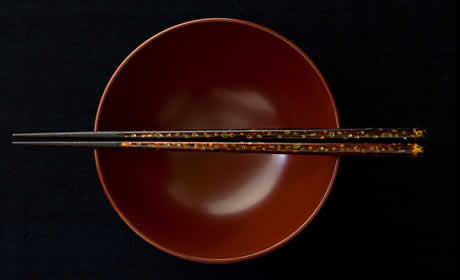 |
Experience the very essence of chopsticks made by craftsmen who don't know the meaning of the word "compromise". |
In Obama, a city famed for its chopsticks, there are only 4 people who are acknowledged to be traditional industrial craftsmen by the Minister of Economy, Trade and Industry--craftsmen who make only the highest quality Wakasa-nuri chopsticks. Using shells, eggshells, etc., and patterned with a polished finish, these traditional chopsticks are still crafted in the same way as in days gone by, making them a true gem. |
![Old Wakasa-Nuri Chopsticks, Seaside Rain [23cm]](https://navibird-cdn-cxgsbjdmfza2adhm.z01.azurefd.net/eg/special/special_jc1008issou/images/01_05.jpg) |
![Old Wakasa-Nuri Chopsticks, Golden Pine [20.5cm]](https://navibird-cdn-cxgsbjdmfza2adhm.z01.azurefd.net/eg/special/special_jc1008issou/images/01_08.jpg) |
![Old Wakasa-Nuri Chopsticks, Mars [23cm]](https://navibird-cdn-cxgsbjdmfza2adhm.z01.azurefd.net/eg/special/special_jc1008issou/images/01_11.jpg) |
|||||
JPY 20,450 |
JPY 20,450 |
JPY 20,450 |
|||||
Layer upon layer of lacquer are crafted by artisans and finished with a polishing technique called "migakidashi".The process of applying lacquer and letting it dry is repeated many, many times, until the craftsman is fully satisfied with the results. In total, this process takes up to around one and a half years. |
||||||||||||||||||||
|
|
|||||||||||||||||||
 |
|||||||||||||||||||
|
|
||||||||||||||||||
Ikigara Chopsticks Style varies with era. These chopsticks have been used as a canvas on which to present a style that matches today's lifestyle. |
||||||
![Ikigara Chopsticks, Evening Sun [20.5cm]](https://navibird-cdn-cxgsbjdmfza2adhm.z01.azurefd.net/eg/special/special_jc1008issou/images/03_28.jpg) |
![Ikigara Chopsticks, Band Chopsticks, Madder Red [23cm]](https://navibird-cdn-cxgsbjdmfza2adhm.z01.azurefd.net/eg/special/special_jc1008issou/images/03_29.jpg) |
|||||
JPY 1,950 |
JPY 1,950 |
|||||
Kihada Chopsticks With Kihada chopsticks, you'll be able to feel the warmth of the trees on your fingertips. |
||||||
![Kihada Chopsticks, Droplets [23cm]](https://navibird-cdn-cxgsbjdmfza2adhm.z01.azurefd.net/eg/special/special_jc1008issou/images/03_32.jpg) |
![Kihada Chopsticks, Chinese Pattern [21cm]](https://navibird-cdn-cxgsbjdmfza2adhm.z01.azurefd.net/eg/special/special_jc1008issou/images/03_33.jpg) |
|||||
JPY 2,950 |
JPY 2,250 |
|||||
Nishijin Woven Chopsticks A combination of weave and lacquer. Designed to embody the Japanese spirit of hospitality. |
||||||
![Nishijin Brocade Chopsticks, Cherry Blossoms [23cm]](https://navibird-cdn-cxgsbjdmfza2adhm.z01.azurefd.net/eg/special/special_jc1008issou/images/03_38.jpg) |
![Nishijin Brocade Chopsticks, Moon [23cm]](https://navibird-cdn-cxgsbjdmfza2adhm.z01.azurefd.net/eg/special/special_jc1008issou/images/03_39.jpg) |
|||||
JPY 2,950 |
JPY 2,950 |
|||||
Nishijin Chopstick Use this elegant Nishijin chopstick bag for your favorite pair of chopsticks. |
||||||
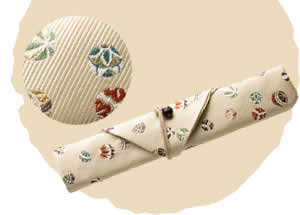 |
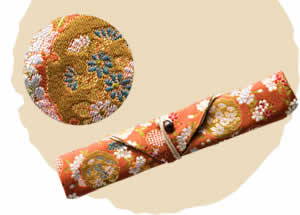 |
|||||
JPY 2,450 |
JPY 2,450 |
|||||
 |
||
In the 11th year of the Kan'ei era (1634) the feudal lord who controlled the Wakasa area gave Wakasa-nuri its name and his whole clan careful protected it. They were deeply attached to their secret and it is even said people were banned from telling other clans about the technique. From the middle to the end of the Edo period was the golden age for Wakasa-nuri. A wide variety of skills were employed including the use of gold and silver leaf, eggshell and shell (Wakasa-nuri's most prominent characteristics), maki-e (the technique of painting on top of lacquer) and many many more. It is said that a total a range of more than 200 different techniques were used. |
 |
|
 |
||
Under the Tokugawa shogunate in the Edo period, the virtues of "Shisso Kenyaku" (meaning simplicity and frugality) were revered. Items made with magnificent Wakasa-nuri were used by only a few: some nobility, samurai and wealthy merchant houses. Most preferred simpler items, and this precluded the use of Wakasa-nuri. This is why there are no everyday Wakasa-nuri items such as soup bowls. |
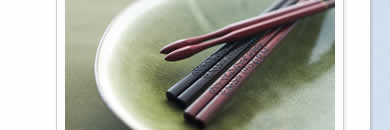 |
|
 |
||

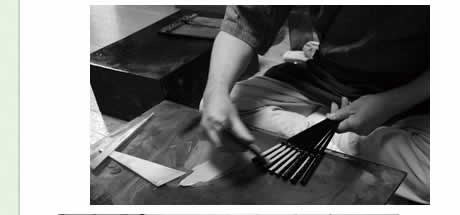
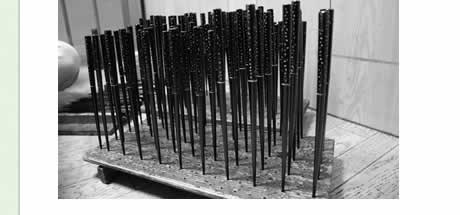
![Tsugaru-Nuri Ice Flower Chopsticks, Red [21cm]](https://navibird-cdn-cxgsbjdmfza2adhm.z01.azurefd.net/eg/special/special_jc1008issou/images/03_05.jpg)
![Wajima-Nuri Chopsticks, Yoimachizuki [22.5cm]](https://navibird-cdn-cxgsbjdmfza2adhm.z01.azurefd.net/eg/special/special_jc1008issou/images/03_12.jpg)
![Shell/Mother-of-Pearl Chopsticks, Starry Night [23cm]](https://navibird-cdn-cxgsbjdmfza2adhm.z01.azurefd.net/eg/special/special_jc1008issou/images/03_19.jpg)
![Tsugaru-Nuri Chopsticks Thin Clouds [23cm]](https://navibird-cdn-cxgsbjdmfza2adhm.z01.azurefd.net/eg/special/special_jc1008issou/images/03_08.jpg)
![Wajima-Nuri Chopsticks, Pine [21.5cm]](https://navibird-cdn-cxgsbjdmfza2adhm.z01.azurefd.net/eg/special/special_jc1008issou/images/03_15.jpg)
![Shell/Mother-of-Pearl Chopsticks, Helwingia [21cm]](https://navibird-cdn-cxgsbjdmfza2adhm.z01.azurefd.net/eg/special/special_jc1008issou/images/03_22.jpg)